Photography: short story of a European innovation
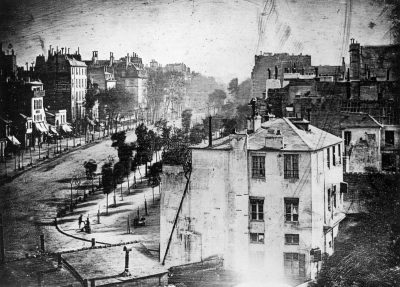 To be able to capture and save images of the world around us and specific moments of our personal lives has been something that man has wished to do since the beginning of time, hence the importance of painting going right back to the earliest of cave paintings. The birth of photography in the 19th century, however, undermined that particular role of painting and opened up a huge range of new possibilities for art, science and society, the repercussions of which, continue to this day.
To be able to capture and save images of the world around us and specific moments of our personal lives has been something that man has wished to do since the beginning of time, hence the importance of painting going right back to the earliest of cave paintings. The birth of photography in the 19th century, however, undermined that particular role of painting and opened up a huge range of new possibilities for art, science and society, the repercussions of which, continue to this day.
Yet the history of photography, even after all the research and studies undertaken to reveal its origins, continues to cause controversy and fuel debate. The purpose of this article, therefore, is only to provide a brief outline of the main characters and events involved from the birth of photography in the 19th century up to the present day.
The Birth of photography
The birth of photography was made possible thanks to four individuals of quite different personality: Joseph Nicèphore Nièpce (1765-1833), W. H. F. Talbot (1800-1877), Louis-Jacques Mandé Daguerre (1787-1851) and Hippolyte Bayard (1801-1887), even though this invention is often only attributed to two of them, Nièpce and Talbot: to Nièpce for having made the first photograph and to Talbot for being the first to print a positive image from a negative one.
Although J. Nicèphore Nièpce is credited with undertaking the first photograph in the 1820s, i.e. capturing a permanent image through a chemical process, Thomas Wedgwood (1771-1805) had already used a similar procedure, using different products and base, fifteen years earlier, but had failed to fix the image. Whereas Wedgwood worked with silver nitrate on a paper and white leather backing to capture his image, Nièpce perfected his own technique using bitumen of Judea on a pewter plate. Talbot also perfected a similar technique. We know that Wedgwood wrote a treatise in 1802, translated into various languages, which described his experiments with silver nitrate, paper and white leather. Nièpce and Talbot, however, perfected their techniques, probably, with no knowledge of Wedgwood’s work, and even less of his treatise
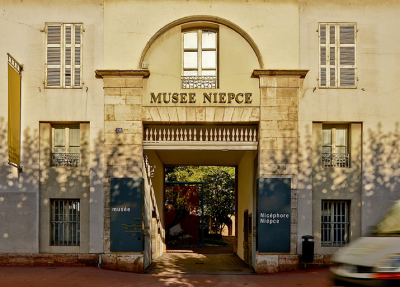
Chalon-sur-Saône is the birthplace of Nicéphore Niépce (1765 – 1833), inventor of photography in 1816 © Musée N. Niépce
The origin of photography was, in fact, a long process in which the advances that several researchers made were not always shared. For more than 50 years individuals were experimenting on how to capture images through chemical and mechanical procedures using various backings and products but their discoveries were not necessarily shared with others. This clearly delayed the birth of photography somewhat, but that only makes the history of photography all the more interesting. Paper and plates were used for images right from the outset up until the invention of the photographic film by George Eastman at the dawn of the 20th century; the pewter plates used by Nièpce were replaced soon after by silver plates and even glass plates; the products used including common salt, sodium thiosulfate, nitrate of silver salts, bitumen of Judea, lavender oil, iodine, chlorine, bromide, mercury, gold, albumin or, later collodion.
Over all these years and investigations, the images gradually became sharper and more light-sensitive. Progress, however, did not only focus on improving the image but also, and hugely important, on reducing exposure time and the weight of photographic equipment. In short, what they were seeking to do was to simplify the photographic process at the same time as improving the quality of the images captured, a process that would accelerate with the use of wet collodion and reach its moment of maximum splendour in the 1960s. While the first photograph La Table Servie taken by Nièpce in 1833 -naturally in black and white- probably needed 8 hours just for exposure time, the Polaroid, 140 years later, provided a colour image exposed, fixed and printed in only 60 seconds.
It should not be forgotten that in the past, just as today, research requires financial assistance. To raise funds, Nièpce, for example, sent his brother to England to try to sell the combustion engine he had developed. This concern for funding also explains Nièpce’s interest several years later in associating himself with Daguerre when they got to know each other in 1826, especially as Nièpce respected Daguerre’s knowledge.
Daguerre, a recognized artist, invented the diorama despite not having any great knowledge of chemistry. He knew a lot more about cameras than Nièpce having made use of the camera obscura. Frustrated with the slow exposure time and obsessed with finding a method to considerably reduce it and provide a more faithful image of reality, they decided to dedicate themselves to research especially into optics, but also into backings and chemicals. In this respect Daguerre was a visionary who understood the importance of speed and sharp image for the future of photography. After various attempts, and after the death of Nièpce, Daguerre invented the Daguerreotype in 1835 although he kept this secret to ward off competition. Three years later he displayed what was believed to be his first photograph, Le Boulevard du Temple, clearly taken from the Place de la République in Paris, in which for the first time two human figures appear.
Daguerre’s insistence on reducing exposure time and improving photographic quality reflects an outstanding aspect of his character. Not only did he want to improve photography, but to make it into a commercial product. To show his invention to the greatest number of people possible, he made the most of his acquaintanceship with François Arago (1786-1853), a French mathematician, physicist and statesman. At first photography was not accepted by the art world, as it was considered a mechanical reproduction process and so was more associated with the scientific rather than the artistic field; Arago, however, being a man of science, quickly understood the importance of Daguerre’s discovery.
With Arago’s help, Daguerre’s discovery spread throughout France and the rest of Europe. Thanks to him, Daguerre and Nièpce’s son, who had become partners on the death of the latter’s father, lived off the income gained for the rest of their lives, a clear example of the importance of personality when it comes to making the most of a discovery. Whilst Nièpce had to send his brother to England to look for financing, Daguerre, with his entrepreneurial spirit and commercial vision, understood the importance of using his contacts to sell a product, even though the French government itself had rejected it some years before.
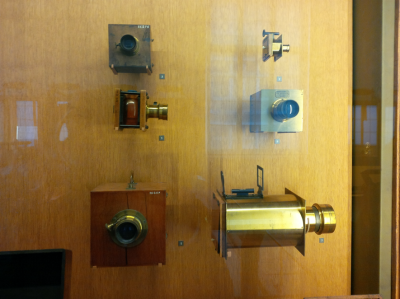
The first cameras exhibited at the Museum of Arts and Crafts in Paris. © R. Belot
The daguerreotype was of great importance during its first twelve years in existence. However, the problems involved in reducing costs and resolving the negative-to-positive process meant that new techniques, developed in the following years, relegated the daguerreotype to second place from 1850 onwards. The image that he and Arago endeavour to promote, although very precise and detailed, had several drawbacks: the image was inverted, exposure time was still lengthy and most importantly, the cost of the material was too high for the general public. Moreover, the image was very fragile and with the slightest rub would disappear. Despite this, various improvements in Europe and United States lead to an enormous boom in its popularity especially in America. The increase in speed made it almost perfect for business allowing it to be used massively in the areas of: portraits, travel albums, architecture books, news reports, etc.
Although the daguerreotype continued to be used practically until the appearance of photographic film at the beginning of the 20th century, the process proposed by Talbot –the calotype- although not reducing exposure time, nor overcoming the problem of sensitivity, did, most importantly, allow the image to be easily reproduced: elements that would adapt much better to future commercial strategies and needs.
Hippolyte Bayard (1801-1887), a French inventor and photographer, was, however, the first to undertake research into printing images on paper. His results produced images of greater quality than those of Talbot, of whom he had no knowledge. Indeed, Bayard unfortunately did not have the same contacts as Daguerre and for this reason even though his work was important, he is usually only credited with a secondary role, if at all, in the history of photography.
From wet collodion to modern photography
As we have seen, Nièpce began his first investigations in the 1810s. In less than 40 years photographic technique developed rapidly in different places and under different personalities almost simultaneously. During these first few years, photography was only available to professionals and devoted amateurs, as it required great knowledge of the materials involved and a considerable amount of equipment. From 1850 onwards, however, the latest techniques opened up photography to a larger number of devotees, not just professionals. During the 1840s a succession of improvements in the procedure and result, as well as in the fixing process came about. The improvements made by Louis Fizeau, Antoine Claudet, John Frederick Goddard and Franza Kratochwila, among many others, provided more solid images, using plates more sensitive to light and a considerable reduction in the volume, and therefore the weight, of photographic equipment.
Furthermore, the use of collodion in photography was discovered in that decade. Its use was decisive, as it printed on contact with light at such speed that movement could also be captured. Wet collodion appeared nearly at the same time in France and in England. Gustave Le Gray used it in 1850 in France, but it was Frederick Scott Archer in England, who really developed it and promoted it. This technique reduced costs. Nevertheless, its main drawback was that the plates had to be prepared beforehand and, having captured the image, the photograph had to be developed immediately. The fragility of the glass plate used as a backing posed another disadvantage.
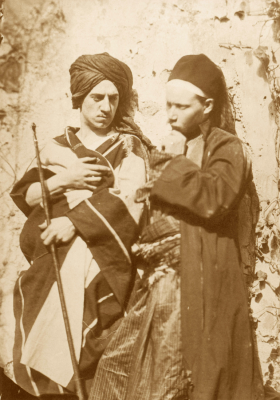
Photos with collodion of the sculptor Auguste Bartholdi and the painter Jean Léon Gérôme, taken in Egypt in 1851 during an ethnographic campaign. © Kempf/musée Bartholdi, Colmar
The daguerreotype technique had already reduced exposure times to a few minutes and to less than a minute in conditions of very strong light with an extra luminous lens. Wet collodion, however, led to a rapidly growing market for images. The glass backing that was initially used soon gave way to other techniques that used a thin metal plate, for example ferrotype, tintype or melanotype. As a metal plate was lighter, more robust, and easier to handle, this development at last made photography available to the non-professional.
If the 1840s had been important in terms of technological advances in the field of photography, the 1850s were noteworthy for the spread to its use and reception by society. In 1851, during the Great Exhibition of London, the Crystal Palace hosted the first great international exhibition of photography, an event that conferred the deserved official recognition of this new art form.
That recognition allowed photography to change habits not only in art, but also in terms of information and communication, as previously the dissemination of information was undertaken either in writing, painting, drawing and engraving. Documentation and information were transformed in an extraordinary way by the arrival of photography, as photographic objectivity replaced other forms of testimony that often went beyond a real and truthful description of the world.
That objectivity of photography played a key role in the documentation and reporting of information. The first expeditions with documentary aims were undertaken (the first photographic reports are from different expeditions to Egypt, where the photograph documents pyramids and other remains of civilizations). The first books with photographic illustrations began to be produced during these years. It should, however, be pointed out that although collodion allowed the publication of this type of book in considerable quantities, Anna Atkins had already published, in 1843, a book exclusively illustrated with photographic images of algae entitled Photographs of British Algae: Cyanotype Impressions. Considered as the first photographic book, Anna worked on it for at least ten years. W. H. F. Talbot had also made a book with photographic images The Pencil of Nature, published between 1844 and 1846.
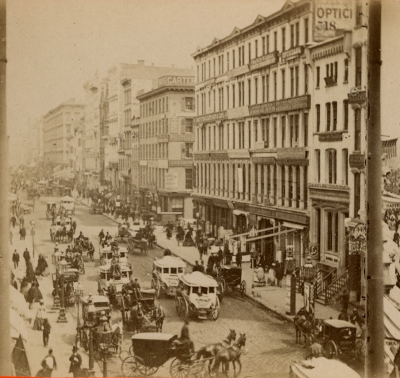
At the end of the 19th century, agencies specialized in photographic postcards, such as Antony’s instantaneous views in New York. Auguste Bartholdi, during one of his stays in the United States, bought this card which represents the avenue of Broadway where he resided. © R. Belot/musée Bartholdi
Photography, moreover, was not to be confined to the pages of certain books. Portraits and indoor family photos had always been a popular theme right from the beginning, with daguerreotypes proudly displayed on walls in houses in France, and carried around in boxes in the United States. As a result of all the developments described, photography then began to move outdoors. With the collodion and ferrotype technique, photographs of daily life, society, customs and events began to appear. The development of the technique was such that photographic genres began to develop spontaneously at an ever-increasing pace. Photography became essential for documenting events, the first photographic reporting of a war being that of the Crimea War (1853-56). The first landscapes, architecture and travel photographs began to appear. In short, a huge number of documentary works were published that have enriched the collective memory ever since in a unique and extraordinary way.
In the early 1850s, only the United States and France had specialist photographic journals. In New York, for example, there were from 1850 The Daguerreian Journal and Photographic Art Journal; In Paris the first photographic society, “La société héliographique pour hâter les perfectionnements de la photographie”, was founded, resulting in the first issue of the La Lumière one year later. Great Britain would have to wait until 1853 for the Photographic Society to be founded. In the German language, the first journal was published in Prague in 1853 Horn’s Photographisches; in 1857 in Vienna appeared the Photographischen Album and in 1860 the Photographischen Archiv. A year later in Vienna, the first photographic society in the German language was founded.
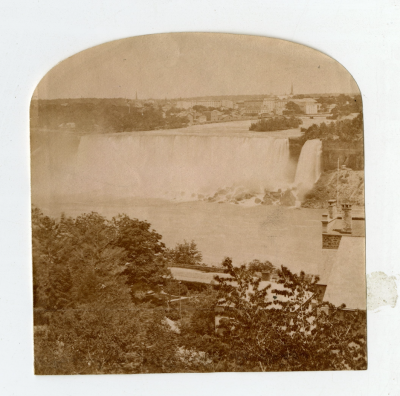
A postcard from Niagara Falls purchased by Auguste Bartholdi during one of his trips to North America (United States and Canada) at the end of the 19th century. © R.Belot/Musée Bartholdi.
It was also during those years that light/exposure time was studied and standardized – abacuses and tables were created for that purpose- and exposure time and scales of photographic sensitivity codified. Later, in a conference in Paris in 1889, light measurement units, objective apertures and plate formats were established.
Photography in the 20th Century
In 1871 Richard Leach Maddox (1816-1902), a British doctor and photographer, frustrated by the difficulties of the wet collodion process, undertook research on how to improve it. Based on his studies of dry gelatin and the light sensitivity of silver bromide, he developed what became known as the gelatin or dry plate process. This process – that would later be improved and commercialized by Charles E. Bennett- did not require the plate to remain wet during the entire process: it could be prepared and stored before and then developed later on. It was dry and hence could be commercialized and stored. This was the beginning of truly commercial films. It was simpler than the wet collodion process and, moreover, reduced exposure time to a quarter of a second. This reduction in exposure time brought photography closer to instant photography as we know it today. Through this procedure, furthermore, light-sensitive paper, using silver bromide, became the type of photographic paper most used during the 20th century.
In 1881 David and Peter Houston invented the roll-film. This was a light, flexible, emulsion-coated support. They sold their patented invention to George Eastman. If exposure time had been considerably reduced (1/25 second) – and therefore the photographic process simplified- now what was require was to make photographic equipment as light and easy to handle as possible. The man who achieved this was George Eastman at the end of the 19th century, eventually creating the concept or idea of instant photography.
In 1888, and following his investigations, George Eastman registered the trade name Kodak and started patenting cameras, using rolls of celluloid as a film. That same year he launched the Kodak 100 Vista on to the market, a camera which could take photos without any technical or chemical knowledge following his famous advertising slogan “You press the button, we do the rest”. Years later he was also to commercialize a smaller, harder film cartridge that could be even more easily inserted and extracted in daylight, in the famous 35mm format. It was a total success and meant cameras could be used without any professional skill, so spreading photography to the general public. With Eastman’s advances, modern photography finally saw the light. From that moment, professionals and amateurs did not have to bother about the chemical processes required for preparing the light sensitive emulsions, but could leave that work to industrial concerns. Photographers simply had to buy a roll of film, take their photos and leave the rest to the photographic laboratories.
Painting had got people used to seeing the world represented in colour. Photography was fully aware of that and, right from the outset, was interested in seeking not only to capture images, but also the colours of those images. Whereas Nièpce had considered the challenge of capturing the colour image at the beginning of the 19th century but had failed to find a solution, Hippolyte Bayard, lacking the developments in the technique that would make it possible, decided to colour his own images. Colouring on black and white images became a specialization for many years until the discovery of the colour photography.
In 1861 the Scottish physicist and mathematician James Clark Maxwell (1831-1879), best known for formulating the classical theory of electromagnetic radiation, suggested the three-colour additive synthesis or method, the idea being that all colours can be reproduced by projecting the same negative of a single image through three filters, red, green and blue. Louis Ducos du Hauron (1837-1920), a French photographer, and Charles Cros (1842-1888), a French physicist, poet and inventor, as well as Frederic Eugène Ives (1856-1937) and Gabriel Lippmann, a Franco-Luxembourgish inventor and photographer, had also been working on similar methods, but instead of mixing coloured light, his methods consisted of subtracting colours from white light using pigments and dyes. It was, however, John Joly (1857-1933) an Irish doctor and scientist, who unified Maxwell’s three filters on a single plate. A little later, in 1904, the brothers Lumière created the autochrome plate which went on sale in 1907. The colour slide was about to be born. In 1935 Léopold Mannes and Léopold Godowsky, repaid the generous funding they received for continuing their investigations by creating Kodachrome film for George Eastman’s company, a film that was launched onto the market in 1941, almost at the same time as the German film Agfacolor.

The Lumière Brothers and their father created the Société anonyme des plaques et papier photographiques, based in Lyon. © Institut Lumière
The photograph, in the middle of the 20th century, seemed to have achieved everything: simplifying the process to the utmost and achieving images not only in black and white, but also in colour and of an exceptional quality. Just when it was thought that everything had been achieved, along came Edwin H. Land (1909-1991) in 1932, a United States scientist and inventor to found the Polaroid laboratories, which in the 1940s focused on investigating a system that could obtain relatively instant images without having to pass through a laboratory for development and copying. Five years later Land presented the first photograph capable of developing itself almost instantaneously, in just 60 seconds. Although the first Polaroid camera took sepia images, in 1963 the company achieved the same image with the same development time, but now in colour. This invention, which amazed the entire world, was the most representative product of the laboratories. Indeed, the instant image of Polaroid was the last technological revolution in photography until the arrival of the digital image at the end of the 20th century.
In contrast to the birth of photography, which took around 40 years, its spread, standardization and social acceptance or recognition was much quicker. The developments that the technique underwent in the second half of the 19th century, not only greatly reduced the exposure times, volume and weight of photographic equipment, but offered a wide variety of high quality, black and white or colour processes. If the Polaroid instant film presented a challenge to an investigation that had begun more than a century earlier, digital photography would set out the base for new challenges that not only photography but also the new technological society would have to face.
Digital photography
Photography, from the beginning, has presented a discourse, a dialogue between the photographer and not only the real, but the fictional or even beyond. In fact, its appearance and development throughout the 19th century caused, as we have already mentioned, a deep crisis in the plastic arts in general. The appearance of the digital camera in the 1990s represented a continuation of that revolution, not only in the technique itself, but also in usage, customs and photographic approach.

Photo taken at the foot of the statue of Christ the Redeemer in Rio de Janiero. We no longer look at the monument but ourselves turning our backs on the monument. © R. Belot
The change from analogue to digital was not simply a technical change. We have not just moved on from producing images based on an exchange between light and chemical energy to working with logical-mathematical symbols, but have adapted to a new way of understanding the nature of photography itself. Digital photography has transformed the protocol and the production site of the images (from the laboratory with its chemical products to the computer and printer). Now, with our electronic devices and from our own home, we can produce and interpret all the images we want.
Indeed, in the digital era, there are many photographers and critics that speak of the death of photography or of the post-photographic era. This is the case, for example, of William Mitchell, Nicholas Mirzoeff, Hans Belting, Fred Ritchin or Joan Fontcuberta. The latter, for instance, heavily criticises that post-photographic era, as he believes that digital photography turns the term and values of photography itself on its head. If, in the analogical era, the image or photo was ruled by “an economy of desire”, by photographing that which one wanted to possess, in the digital era the photograph has become omnipresent and has colonized our lives and our universe in a disquieting manner.
Whereas the analogical era paid tribute to a precise and concrete moment, in the digital era there appears to be a kind of overpowering and obsessive need to communicate through instant and often trivial images. The millions of “selfies” sent daily on our mobile phones, often without any accompanying text pay tribute to the digital age, but also appear to sound the death knell for the “art” of photography and even pose a threat to language itself.
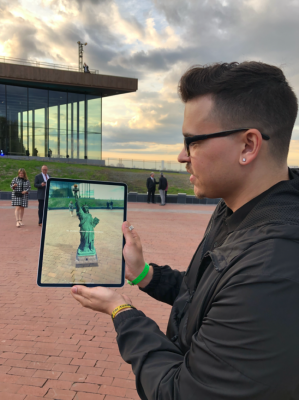
The camera is replaced by digital tablets, which can, as here, on Liberty Island (NYC), use the hologram technique. © R. Belot
The history of photography is complex and fascinating. It is a history that runs parallel to technological and industrial advances with an enormous cultural impact. As professor William Schaefer has pointed out, it is an assemblage of Arabic optics, Italian and Dutch perspectivalism, Dutch lens-making, and French and English Chemistry, but is also a history that passes through fashions, uses and aesthetic stages, linked to the socio-cultural changes of each particular era, all of which we have not been able to fully deal with here due to a lack of space.
From the first image captured through the camera obscura, to the colour film of Kodak or Polaroid, photography was given the task of capturing history and events, of becoming an immediate witness of the world in all its objectivity, but at the same time subverting that reality and, at times, capturing that which is not actually seen. Today, with the boom in the digital image, thousands of photographs constantly arrive to us via the cinema, television, video and our own electronic devices, images that continue to demonstrate the documentary appeal of the photograph, its power as an artistic object, by either reproducing reality or manipulating it.
That omnipresence of the image in which we are immersed obliges us to reflect not only on the way of communicating and perceiving reality, but also on the new dialogue that is established between those images and our perception of reality and ourselves. How should we behave faced with such an avalanche of images?
Joan Fontcuberta makes an interesting comment on this issue. He points out that in Ridley Scott’s film Blade Runner (1982), the replicants always carry photographs in order to construct a past that, although never existed, allows them to create a memory, an identity that provides them with the sensation of being “real”.
Elena Roig Cardona
Bibliography
AMAR, Pierre-Jean. La photographie histoire d’un art. Aix-en-Provence : Edisud, 1993
École de photographie Spéos, labellisé « Maison des illustres » par le Ministère de la Culture. Maison Nicèphore Niepce [en ligne]. Disponible sur : http://www.photo-museum.org/fr/# (Consulté le 14/05/2019)
GUIYOT-CORTEVILLE, Julie, CAUJOLLE, Christian, CONAN, Joël. Une autre histoire de la photographie : les collections du Musée français de la photographie. [Bièvres], Musée français de la photographie : Flammarion, 2015
KOETZLE, Hans-Michael. 50 Photo Icons. L’histoire derrière les images. Editorial Taschen
LEMAGNY, Jean-Claude, ROUILLÉ, André (directeurs). Histoire de la photographie. Paris : Bordas, 1986
MARZAL FELICI, Javier. Pensar la fotografía en la era digital. A propósito del libro de Joan Fontcuberta La cámara de Pandora. La fotografía después de la fotografía. adComunica [en ligne]. 2011, nº 02, pp. 221-225. Disponible sur : http://www.adcomunicarevista.com/ojs/index.php/adcomunica/issue/view/2/showToc (Consulté le 13/05/2019)
ROSSENBLUM, Naomi. Une histoire mondiale de la photographie. Paris : Editions Abbeville, 1997

 Université Jean Monnet
Université Jean Monnet